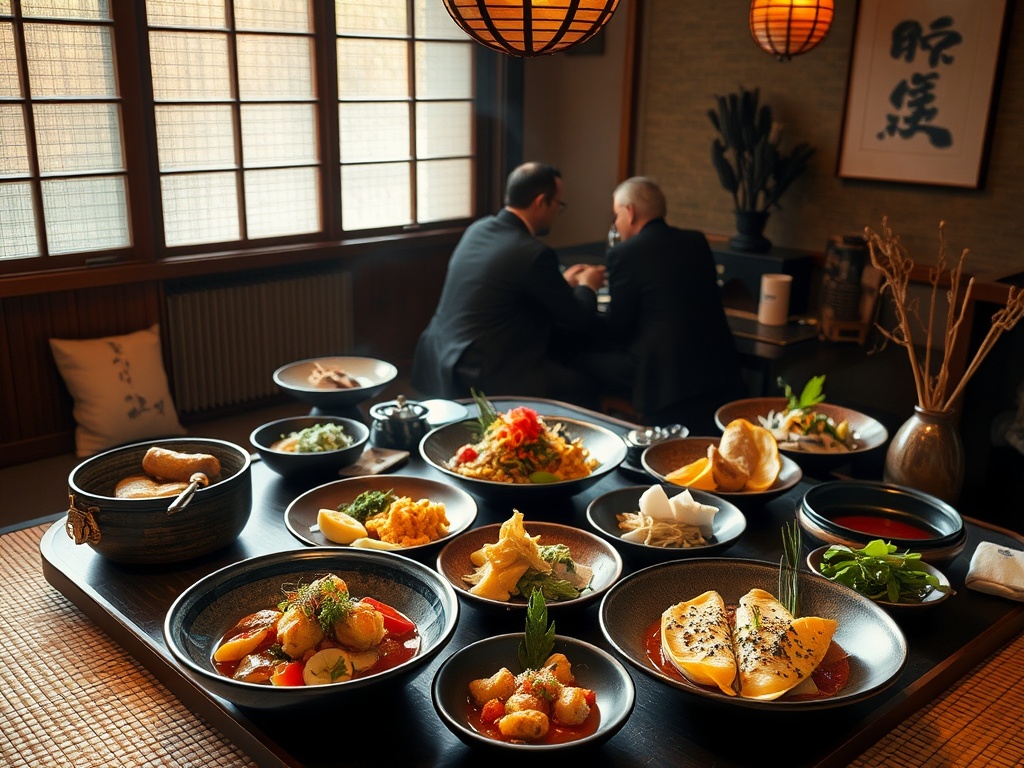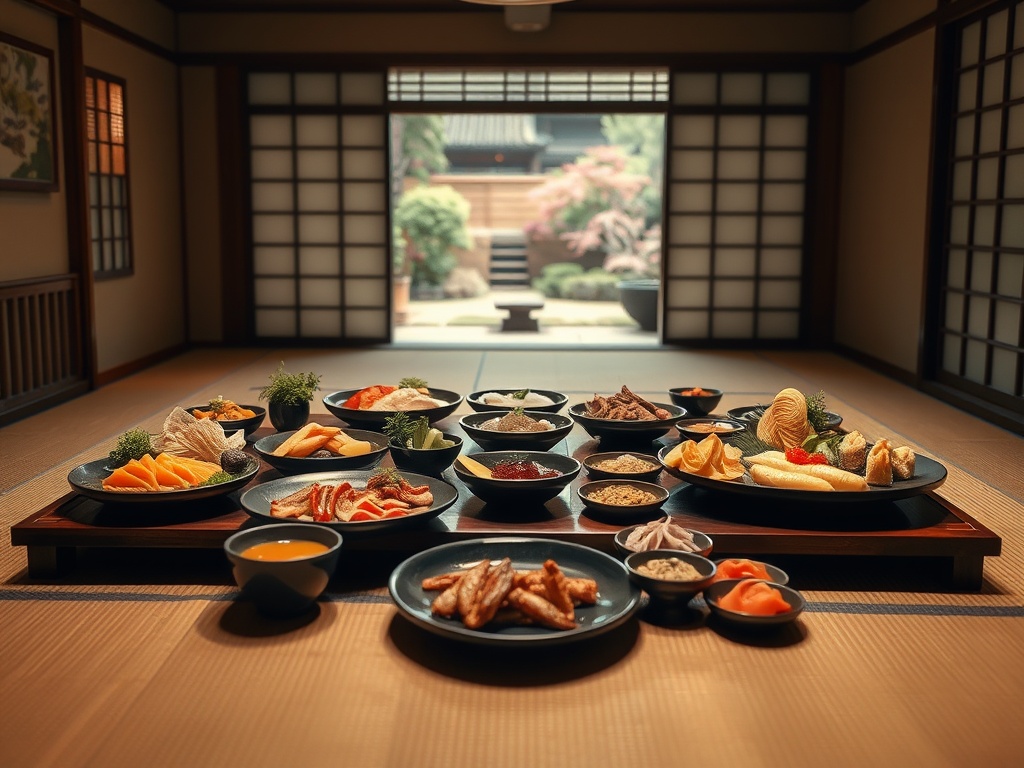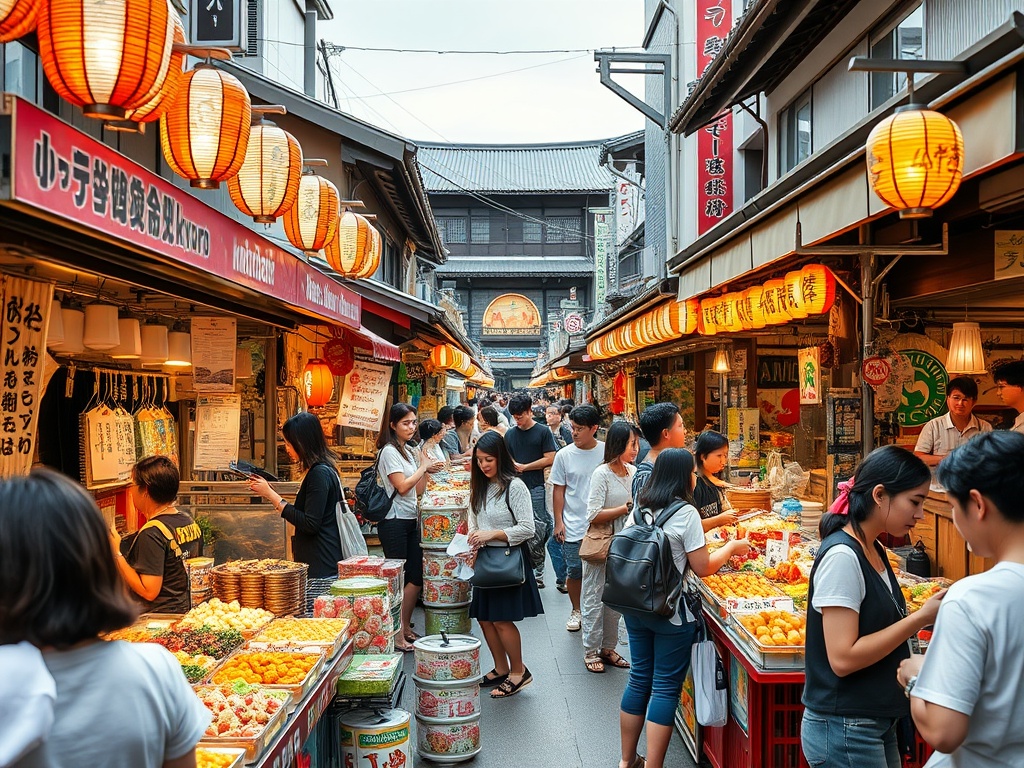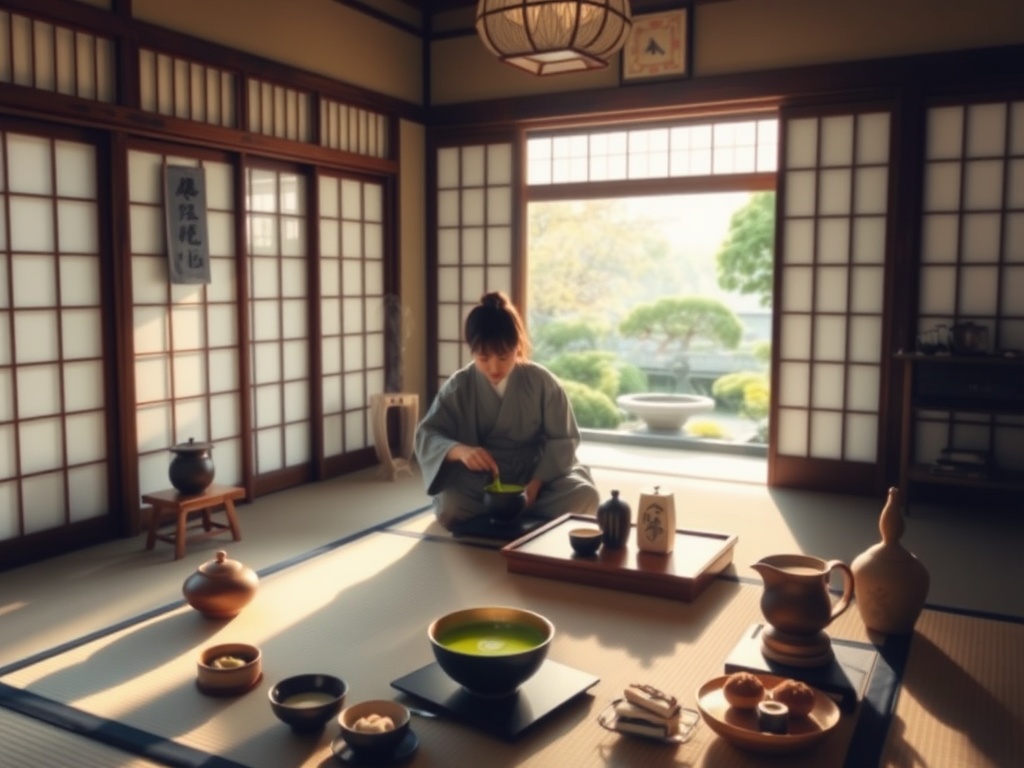Unveiling the Art of Kaiseki: Kyoto’s Culinary Masterpiece
Win a Free Trip to Japan!
Experience cherry blossoms and ancient temples
Embark on a gastronomic journey through the heart of Japan with Kaiseki, Kyoto’s exquisite culinary art form. This traditional multi-course dining experience captures the essence of Japanese aesthetics, seasonal ingredients, and meticulous presentation. Kaiseki isn’t just a meal—it’s a symphony of flavors and an exploration of cultural heritage that enchants the senses and nourishes the soul.
Kaiseki is deeply rooted in the principles of Japanese Zen Buddhism and the tea ceremony. It is a delicate balance between taste, texture, appearance, and colors. Each dish is crafted to reflect the seasons, with an emphasis on fresh, local, and high-quality ingredients. The meal is designed to be served in harmony, creating a flow that tells a story, much like a narrative in a book.
While each Kaiseki experience can differ, there are certain elements that are often included to deliver a comprehensive culinary journey:
- Sakizuke (先附): An appetizer that sets the tone for the meal, often a small and delicate dish.
- Suimono (吸い物): A clear soup that is lightly seasoned, offering a gentle start to the meal.
- Hassun (八寸): Seasonal platter that emphasizes variety and presentation.
- Mukozuke (向付): A sashimi dish, showcasing the fresh fish of the day.
- Takiawase (炊合せ): A dish of vegetables, meat, or fish served together to highlight their natural flavors.
- Shokuji (食事): Rice, miso soup, and pickles that serve as a staple throughout the meal.
- Mizumono (水物): A seasonal dessert or fruit to end the meal on a sweet note.
Kyoto is dotted with renowned Kaiseki restaurants that offer this unique dining experience. Some of the most notable ones include:
| Restaurant | Location | Notable Feature |
|---|---|---|
| Kikunoi | Higashiyama | Michelin-starred excellence with a focus on tradition |
| Hyotei | Nanzen-ji | Over 400 years of history and serene garden views |
| Nakamura | Central Kyoto | Family-run with a personalized touch |
Street Food Adventures: Savoring Kyoto’s Hidden Gems
When you think of Kyoto, visions of serene temples and historic shrines might come to mind. However, beyond the tranquil gardens and traditional tea houses, Kyoto’s vibrant street food scene beckons with irresistible aromas and flavors that promise to transform your culinary journey. These hidden gems are not just about satiating hunger; they offer a glimpse into the local lifestyle, reflecting the rich tapestry of culture and tradition that the city embodies.
Nestled in the heart of Kyoto, Nishiki Market is a treasure trove of culinary delights waiting to be discovered. Often referred to as “Kyoto’s Kitchen,” this bustling market stretches over several blocks, each stall showcasing a myriad of flavors that represent the essence of the city. Here, you can savor the delicate taste of yuba, or tofu skin, a local specialty that is both simple and exquisite. For a more adventurous palate, try the grilled skewers of yakitori, where tender chicken is infused with a smoky, savory glaze.
No street food journey in Kyoto is complete without indulging in its array of sweet delights. Traditional wagashi, or Japanese sweets, are a must-try, especially the famed matcha-flavored delicacies that pay homage to Kyoto’s tea heritage. Imagine biting into anmitsu, a delightful concoction of agar jelly, sweet red bean paste, and seasonal fruits, offering a symphony of textures and flavors that dance on the tongue. As you wander through the streets, the sight of freshly made taiyaki, a fish-shaped cake filled with sweet fillings, will undoubtedly draw you in with its inviting aroma.
As the sun sets, the allure of Kyoto’s night markets comes alive, offering a different perspective on the city’s street food culture. These nocturnal bazaars are where locals and tourists alike gather to enjoy an array of street eats under the starry sky. Dive into a bowl of steaming ramen, where every slurp unravels the depth of flavors crafted by expert hands. For an iconic Kyoto snack, the grilled mochi on sticks, glazed with a savory-sweet sauce, provides a satisfying and memorable experience.
Tea Time Mysteries: Discovering Kyoto’s Matcha Magic
In the heart of Kyoto, where tradition and innovation blend seamlessly, matcha emerges as a revered symbol of the city’s cultural and culinary identity. This vibrant green tea, renowned for its earthy flavor and health benefits, is more than just a beverage. It’s an integral part of Kyoto’s rich heritage, offering a unique taste of Japan’s ancient past while catering to the modern palate. Exploring Kyoto’s matcha culture is akin to unveiling a mystery, where every sip and every serving tells a story of centuries-old rituals and contemporary creativity.
The journey into Kyoto’s matcha magic often begins with the traditional tea ceremony, a deeply symbolic practice that transcends mere consumption. The ceremony is an art form, characterized by its precise movements and serene atmosphere. As you enter a tea house, the world outside fades, and you’re drawn into a realm of contemplation and mindfulness. The vibrant hue of the matcha, whisked to perfection, reflects the care and dedication that goes into every aspect of this ritual. With each sip, you connect with the essence of Kyoto, experiencing a moment of tranquility and timelessness.
While the traditional tea ceremony offers a glimpse into the past, Kyoto’s modern culinary scene embraces matcha in innovative ways that captivate both locals and tourists. From matcha-infused pastries to creamy matcha lattes, the creativity knows no bounds. Cafés throughout the city experiment with matcha, creating desserts that are not only visually stunning but also a delight to the taste buds. Imagine indulging in a matcha parfait layered with red beans and mochi, each bite a harmonious blend of textures and flavors. These contemporary delights offer a fresh perspective on matcha, allowing you to savor its versatility while nurturing a connection to Kyoto’s storied traditions.
Beyond Sushi: Exploring Kyoto’s Tempting Tofu Tradition
Kyoto’s culinary scene is a treasure trove for those eager to explore beyond the well-trodden path of sushi and sashimi. One such gem is the city’s unique take on tofu, an ingredient that embodies simplicity yet offers a profound depth of flavor. Tofu in Kyoto is more than just a protein alternative; it is an art form that captures the essence of the city’s rich culinary heritage. From delicate yudofu simmered in a light broth to the creamy indulgence of oborodofu, Kyoto’s tofu tradition offers a tantalizing journey for the taste buds and a glimpse into the local way of life.
In Kyoto, tofu is revered not just for its nutritional benefits but for the craftsmanship that goes into its creation. Local artisans meticulously produce tofu by hand, preserving techniques that have been passed down through generations. This dedication results in tofu with a texture and taste that is unparalleled, offering a soft, melt-in-your-mouth experience that is both satisfying and memorable.
One of the most iconic tofu experiences in Kyoto is yudofu, a simple yet elegant dish that highlights the purity of tofu. Served in serene settings, often overlooking traditional Japanese gardens, yudofu is a testament to the beauty found in simplicity. It is accompanied by a subtle dipping sauce that enhances its delicate flavor without overpowering it, allowing diners to appreciate the tofu’s natural essence fully.
When exploring Kyoto’s tofu tradition, there are several must-try delicacies that showcase the versatility of this humble ingredient:
- Yudofu: A classic dish of boiled tofu served with a light dipping sauce, celebrated for its simplicity.
- Oborodofu: Creamy, custard-like tofu that offers a rich and luxurious texture.
- Tofu Skin (Yuba): Delicate sheets of tofu skin, prized for their silky texture and subtle flavor, often enjoyed as a light appetizer.
- Tofu Dengaku: Grilled tofu skewers brushed with a savory-sweet miso glaze, providing a delightful contrast of flavors.
For those eager to delve into this culinary tradition, Kyoto offers a plethora of establishments where tofu takes center stage. From traditional tofu houses nestled in the historic district of Gion to modern eateries that reinvent classic dishes, the city’s tofu offerings are as diverse as they are delicious.
One highly recommended spot is Nanzenji Junsei, located near the picturesque Nanzen-ji Temple. Here, yudofu is served in a tranquil setting, providing an authentic taste of Kyoto’s tofu tradition. Another notable mention is Tousuiro, a tofu restaurant that combines innovative flavors with time-honored techniques, offering diners a unique culinary adventure.
Sweet Secrets: Indulging in Kyoto’s Wagashi Wonders
Step into a world where tradition meets artistry, and let the sweet secrets of Kyoto’s wagashi transport you to a realm of exquisite taste and cultural richness. These delicately crafted Japanese confections are more than just desserts; they are a celebration of nature, seasons, and the skilled hands that shape them. Each piece tells a story, inviting you to savor not only its flavor but also the beauty and philosophy embedded within its creation.
Wagashi are traditional Japanese sweets that are often consumed during tea ceremonies or as part of a seasonal celebration. The creation of wagashi is an art form that requires precision and a deep understanding of the natural ingredients used. From the vibrant colors to the intricate designs, every detail is meticulously planned to reflect the changing seasons and the fleeting beauty of nature.
In Kyoto, the heart of Japan’s cultural heritage, wagashi artisans draw inspiration from the city’s picturesque landscapes and timeless traditions. Whether it’s the delicate cherry blossoms of spring or the fiery hues of autumn leaves, these sweets capture the essence of Kyoto’s seasonal beauty in every bite.
Embark on a sweet journey through Kyoto with these must-try wagashi delights, each offering a unique taste of the city’s culinary artistry.
- Namagashi: Soft and moist confections often filled with sweet bean paste, crafted into stunning shapes that represent the current season.
- Yatsuhashi: Kyoto’s iconic cinnamon-flavored confection, available in both baked and unbaked forms, offering a delightful crunch or a chewy texture.
- Sakuramochi: A springtime favorite featuring sweet rice cake wrapped in a cherry blossom leaf, creating a harmonious blend of sweet and salty.
To truly appreciate the art of wagashi, a visit to Kyoto’s historic sweet shops is a must. These establishments have been perfecting their craft for generations, offering a glimpse into the world of traditional Japanese confectionery.
One such renowned shop is Toraya, a name synonymous with exquisite wagashi since the late 16th century. Their creations are not only treats but works of art that reflect centuries of tradition and expertise. Another gem is Shioyoshiken, known for its seasonal offerings that capture the essence of Kyoto’s beauty. As you step into these shops, you’ll be enveloped by the aroma of sweet delights and the warm hospitality of artisans eager to share their passion with you.
Temple Delicacies: Sacred Flavors of Kyoto’s Shojin Ryori
Dive into the tranquil world of Kyoto’s Shojin Ryori, where culinary simplicity meets spiritual devotion. This revered vegetarian cuisine, rooted in Buddhist monastic traditions, offers a transformative experience for those seeking to explore Kyoto’s sacred flavors. As you journey through this ancient city, let Shojin Ryori guide you to a deeper understanding of the harmony between nature and nourishment.
At the heart of Shojin Ryori lies a philosophy that transcends mere sustenance. It is a culinary practice that epitomizes mindfulness and respect for all living things. This sacred meal is grounded in the principle of avoiding harm, with dishes crafted from seasonal vegetables and plant-based ingredients. Each meal is a reflection of the changing seasons, embodying the natural rhythm of life. As you savor each bite, you are invited to contemplate the intricate balance of flavors and the serenity it brings.
Kyoto’s temples are sanctuaries not only of spiritual enlightenment but also of culinary art. Here, Shojin Ryori isn’t just a meal; it’s a journey through centuries-old traditions. Temples like Nanzen-ji and Kodaiji offer an immersive experience where you can enjoy this sacred cuisine amidst serene gardens and historical architecture. As you sit in the quietude of a temple dining hall, the simplicity of Shojin Ryori becomes profound, each dish a testament to the monks’ dedication to balance and harmony.
Preparing Shojin Ryori is an art form that requires patience and precision. The cooking process is a meditative practice, where intention and care are infused into every step. From the gentle simmering of dashi broth to the delicate arrangement of vegetables, each aspect of preparation is an act of mindfulness. This culinary ritual encourages you to slow down, appreciate the beauty in simplicity, and find peace in the present moment.
The Fermentation Craze: Unearthing Kyoto’s Miso Marvels
When you think of fermentation, Kyoto might not be the first place that comes to mind. Yet, nestled amidst its ancient temples and serene landscapes lies a culinary secret that has been quietly captivating the palates of locals and visitors alike—Kyoto’s Miso Marvels. This quintessential Japanese ingredient, known for its rich umami flavor, is a testament to the city’s knack for turning the simple into something extraordinary. Dive into the world of fermented flavors and discover how Kyoto’s unique approach to miso is transforming the way we experience Japanese cuisine.
At the heart of Kyoto’s miso magic is the art of fermentation, a time-honored tradition that has been perfected over centuries. Kyoto’s climate, with its distinct seasons and nurturing environment, provides the ideal conditions for crafting miso that is both complex and nuanced. The process begins with locally sourced soybeans and koji—a type of mold that is essential to the fermentation process. As the miso ages, it develops a depth of flavor that is unparalleled, offering a taste that is both savory and subtly sweet.
Kyoto’s miso isn’t just about taste; it’s about the philosophy of balance and harmony. The artisans who craft this beloved paste approach it with the same mindfulness and respect that are characteristic of the city’s cultural practices. As you explore the streets of Kyoto, you’ll find small, family-run miso shops where the craft has been passed down through generations, each offering a unique take on this savory staple.
Kyoto’s culinary landscape offers an array of opportunities to experience miso in its many forms. From traditional dishes like miso soup and dengaku—grilled tofu or eggplant topped with a sweet miso glaze—to innovative modern interpretations that incorporate miso into unexpectedly delightful contexts, the city is a playground for those eager to explore the depth of this ancient ingredient.
Restaurants and eateries throughout Kyoto pride themselves on their unique miso creations, often highlighting the local terroir and seasonal ingredients. As you dine, you’ll notice how miso enhances the natural flavors of each dish, adding a layer of complexity that elevates the dining experience. Whether you’re savoring a simple bowl of miso soup or indulging in a gourmet tasting menu, the presence of miso is a reminder of Kyoto’s rich culinary heritage and its ability to surprise and delight the senses.
Seasonal Surprises: Kyoto’s Bounty from Farm to Table
Kyoto, the cultural heart of Japan, is a city that thrives on tradition and innovation, particularly when it comes to its culinary offerings. The city’s commitment to seasonality is not just a culinary preference but a deeply ingrained philosophy that celebrates the natural rhythm of life. With each passing season, Kyoto’s landscape transforms, and so do its flavors. From the first tender shoots of spring to the harvest’s bounty in the fall, Kyoto’s farm-to-table approach ensures that every dining experience is a celebration of nature’s gifts.
In Kyoto, the concept of shun—eating ingredients at the peak of their season—is a guiding principle. This age-old practice not only ensures optimal flavor and nutrition but also fosters a deep connection with nature. Local chefs and home cooks alike eagerly anticipate the arrival of seasonal ingredients, each heralding a new chapter in the culinary year. From the vibrant green of spring’s bamboo shoots to the rich, earthy tones of autumn’s wild mushrooms, Kyoto’s cuisine is a reflection of the changing seasons, offering a feast for the senses.
For those seeking an immersive culinary journey, Kyoto offers a plethora of farm-to-table experiences that highlight the city’s seasonal bounty. Visit local farms and markets to witness firsthand the dedication and care that go into cultivating these prized ingredients. Many restaurants take pride in sourcing their produce directly from nearby farms, ensuring that what’s on your plate is as fresh and flavorful as possible.
Here’s a glimpse into some of the seasonal delights you might encounter:
- Spring Delicacies: Delicate bamboo shoots and tender green peas signal the arrival of spring, often featured in light, refreshing dishes.
- Summer Bounty: Juicy tomatoes and sweet corn are summer staples, celebrated in vibrant salads and chilled soups.
- Autumn Harvest: The earthy flavors of mushrooms and chestnuts dominate autumn’s offerings, making their way into hearty stews and savory rice dishes.
- Winter Comforts: Winter brings root vegetables and leafy greens, perfect for warming soups and stews that nourish the soul.
For an authentic taste of Kyoto’s seasonal surprises, a visit to the local markets is a must. These bustling hubs are where the city’s chefs and food enthusiasts gather to source the freshest produce. Nishiki Market, often referred to as Kyoto’s pantry, offers a vibrant array of seasonal ingredients and artisanal products. As you wander through the stalls, you’ll be greeted by the enticing aromas and vibrant colors that define Kyoto’s culinary landscape, providing a sensory experience that is as enlightening as it is delicious.



